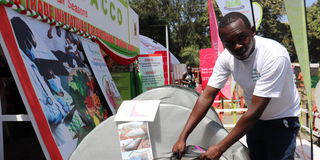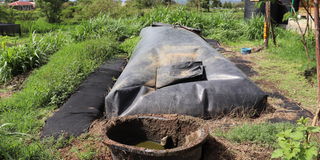A system able to produce biogas from household waste

Samuel Ndolo explains the Flexibiogas system.
Many rural communities still heavily rely on firewood as their primary energy source, a practice that negatively impacts both the environment and human health.
The time taken to find the firewood is a burden carried by young girls and women, which would otherwise be used more gainfully.
While some are still on the road to transition to using alternative energy sources like biogas (gas produced from organic materials like animal waste and food scraps) using waste from animals, this technology has now transitioned over time.

A biogas system using animal waste to produce animal waste.
Gone are the days when household waste was just animal feed or used for compost.
Just a few decades ago, biogas production primarily relied on animal waste. Today, there is a growing movement to mitigate greenhouse gas emissions by converting organic waste from markets and households into biogas.
The Nakuru County Waste Management Policy states that Nakuru County produces an average of 56.6 percent of waste generated at the household level and agricultural produce food markets, hotels, and restaurants.
This waste can make a good source of energy for many households.
Samuel Mutua Ndolo, who works with FlexiBiogas, says they are on a mission to save the world from pollution and are taking organic waste to produce biogas and organic fertilizer.
“A while back, biogas was being produced from animal waste. Now, there’s an improved technology that accommodates any biodegradable material and is not limited to any farmer who doesn’t have livestock,” he says.
The system, he explains, can generate energy from a variety of biodegradable materials, including market waste, food scraps, farm residues, water hyacinth, and other organic matter.
“Once organic material is fed into the system, it produces two things- biogas for energy and bio-slurry (a combination of manure and water). The bio-slurry is used as organic fertilizer- foliar fertilizer or liquid compost used to boost crops with nutrients for a successful yield,” Ndolo says.
The bio-slurry also has a pungent smell, which Ndolo points out is an effective pest repellent.

A system used to produce biogas from household waste.
He emphasizes that unlike chemical fertilizers, which have long been associated with harming soil health and posing risks to human well-being, this by product is environmentally friendly and doesn’t harm the soil or kill important microorganisms.
The components of the biogas system include a biogas digester, greenhouse, piping, shade net, valves, and twin burner stove.
To use a standard six cubic meter biogas system, about 500 kg of organic waste is required, which is mixed with water in a 1:1 or 1:1.5 ratio.
This initial input, Ndolo notes, can produce enough biogas to provide cooking energy for one to two weeks maintained by adding one or two 20 kg buckets of waste once or twice a week, which he advises should be fed in the morning.
